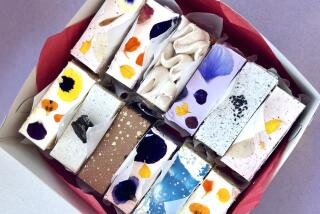Chiffon cake: heavenly light, deceptively rich-tasting
- Share via
Heralded as “the first new cake in 100 years” when it was introduced, the chiffon cake — one of the darlings of midcentury cuisine — became famous for its wonderfully light and airy texture, seemingly weightless as angel food but with a moist tenderness almost like a rich butter cake. And the delicate creation was originally developed by a Los Angeles insurance salesman.
Though it may seem like a Betty Crocker-era relic, the cake is as relevant today as it was when it first revolutionized the baking world more than half a century ago. Chiffon is really a simple cake to make, lending itself to a host of flavor possibilities and accents. Try a classic orange variation, but complement the flavors a little with rich hazelnuts. Fold cacao nibs into a chocolate cake for extra depth and crunch. Or look to Southeast Asian flavors for inspiration with a fragrant pandan coconut chiffon cake. The options seem endless.
Harry Baker is the salesman who came up with the original formula in the late 1920s. He moonlighted as a caterer and was soon baking the popular creation for the Hollywood elite. He even sold cakes to the Brown Derby, which featured the dessert on its menu.
Baker kept his original formula secret for decades. Finally, in the late 1940s, he sold the recipe to Betty Crocker’s parent company, General Mills.
General Mills fine-tuned the method and ingredients over 11 months and released the chiffon recipe in 1948. With a heavy marketing campaign, it wasn’t long before the cake became a national sensation.
Los Angeles Times food expert Marian Manners (the pseudonym used by various Food section editors, cooking instructors and writers of the time) touted the release on Feb. 15, 1948, under the headline “Sensational New Recipe for Cake.” The announcement prompted more than a thousand letters and phone calls from readers. The Times soon featured the dessert as part of a cake demonstration for its own “Times College of Cookery.”
Chiffon was certainly a new kind of cake. A type of sponge cake, chiffon uses whipped egg whites for its light and airy “lift,” giving it the look and feel of angel food. But to give it that almost buttery richness — and the moist crumb not normally found in a sponge cake — chiffon included a unique ingredient for cakes at the time: vegetable oil. Oil, unlike butter, remains liquid at room temperature, keeping the cake moist and tender.
Best of all, the method is simple, requiring a handful of basic ingredients and a few kitchen tools.
The dry ingredients — flour, sugar, a pinch of salt and a little baking powder — are sifted together in a large bowl. (While the egg whites provide most of the lift on this cake, a little chemical leavener helps to seal the deal.) Add the liquids — oil, egg yolks, a little milk (or water) and flavoring, such as vanilla — and beat everything together to form a smooth batter.
The egg whites are whipped to form a stiff meringue. To get the most lift from the whites, use room-temperature eggs, and be sure to beat them using a very clean bowl and beater — any traces of dirt or grease can decrease the volume of the meringue.
Beat the whites with a little cream of tartar over low speed to strengthen the structure of the bubbles as they form, then slowly “rain” in the sugar with the mixer going. Keep beating (you can increase the speed of the mixer), just until the whites form “stiff peaks” when the beater is lifted. Check the eggs periodically as they thicken; if the eggs overbeat (they will look crumbly), their delicate structure will break down and won’t be able to support and lift the cake as it bakes.
Gently fold the eggs into the batter before transferring it to the pan. As the cake bakes, it literally puffs up in the oven and can rise over the top of the pan by a few inches. It’s done when the cake is golden and springs back gently when touched.
Immediately invert the cake over a wine or tall soda bottle as soon as it’s out of the oven. This gives the proteins in the cake time to set up as it cools, so the delicate structure doesn’t collapse under its own weight.
Because of that light structure, chiffon cakes work best lightly garnished. Don’t weigh the cake down with a heavy frosting. Dust the cake with powdered sugar, maybe a little sweetened cocoa powder. Or leave the cake alone, sliced thin and served with a dollop of freshly whipped cream and fresh berries.
As it promoted the cake, General Mills marketed variations — 14 of them at one time — for the chiffon. And with such a simple method, the cake easily lends itself to a little creativity.
For a chocolate chiffon, replace a little of the flour with unsweetened cocoa powder. A sprinkling of cacao nibs lends a nice crunch to the cake. Dust the cake with a little powdered sugar for added sweetness, or give the cake extra depth with a drizzle of rich chocolate glaze.
Or go for something more exotic. Pandan is a popular flavor in Southeast Asian cuisine, with a fragrant earthy nuttiness that is a natural complement to coconut in so many dishes (think Thai coconut sticky rice). The flavor is also popular in sponge cakes, including chiffon, many of which are tinted a pistachio shade of green (whether naturally from extract or juice, or artificially with food coloring).
Substitute coconut milk and pandan juice for the milk in the recipe, and use pandan essence in place of vanilla. Frost the cake with a drizzle of coconut glaze (coconut milk whisked with a little powdered sugar) and a sprinkling of toasted coconut.
More to Read
Eat your way across L.A.
Get our weekly Tasting Notes newsletter for reviews, news and more.
You may occasionally receive promotional content from the Los Angeles Times.










